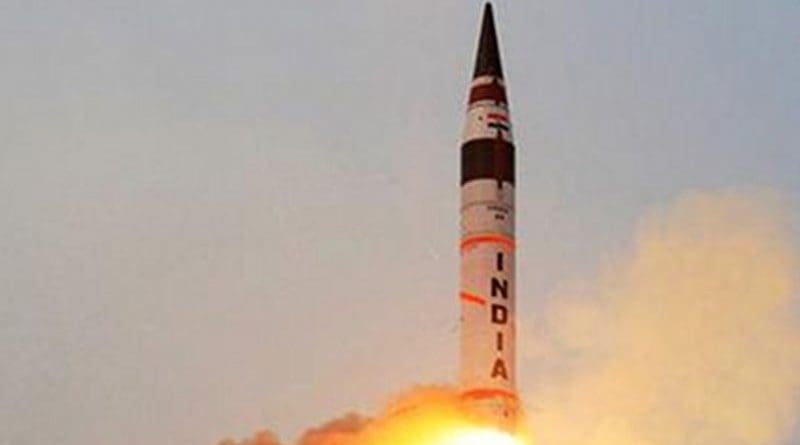Implications Of India’s Missile Program And Non-Proliferation Regime – OpEd
By Asma Khalid*
India is believed to have fastest growing missile program of the world. It is estimated that India possess enough fissile material to produce 90 to 110 nuclear warheads and its fissile material production is increasing rapidly.
India’s exiting missiles that have direct implications for Pakistan are Prithvi I and Prithvi II with the range of 150/350 km, whereas second family of ballistic missile Agni- series has also direct implications for Pakistan, and on the other hand it is designed to reach china as well. So India’s missile program has not only triggered Pakistan’s concerns, but the other regional states like China that considers the Agni-V as a threat to their security and regional stability. Currently, India possesses ballistic missiles, nuclear-capable aircraft and longer-range ballistic missiles. Though, India claims that it has kept its warheads separate from launchers but higher level of readiness is matter of great concern of regional powers.
India’s Missile Defence System has potential to upset the strategic stability of region. India aims to acquire sophisticated Missile capabilities and Ballistic Missile Defence System to achieve two main objectives: First, to deter regional powers, China and Pakistan; Second, to emerge as regional power to establish its hegemony in region. To achieve these objectives India is building the huge stockpiles of fissile material. Such factors are posing more drastic security challenges to the South Asia.
India has large number of operational missiles in its inventory. India’s expanding missile capabilities with the significant improvement in range, accuracy, Payload and reliability, is not only forcing the regional states to enhance their capabilities to ensure their security, but also have the potential to instigate the arms race in region. India initiated its missile program in 1980s (much earlier than Pakistan) and brought greater insecurity, instability and tension and forced the regional states, such as traditional rival Pakistan to build up its nuclear capabilities to ensure its security and maintain stability in region.
Indian missile developments have serious implications on regional as well as global level. On regional level, it has enforced the traditional rival Pakistan to enhance it missile as well as nuclear capabilities. Secondly, various kinds of missiles increase with large inventory has enhanced the tension in region and increased the chances of escalation between Pakistan and India on one side, and between India and China on other side. Whereas at global level, the sophisticated missile developments with improved ranges and payload have serious implications on the non-proliferation regime, as it is encouraging the other regional states to pursue their nuclear and missile programs to counter Indian offense.
Consequently, the recent developments in the Indian Missile program are a matter of great concern for the competing regional states, especially for Pakistan. Developments in its missile as well as Ballistic Missile Defence System (BMD) and upcoming collaboration of India with US, Russia and Israel has added new dimensions to the regional stability and security equation. Especially, introduction of BMD system have posed negative implications on both Pakistan and China and possess the ability to give rise to arms race in region due to existence of action-reaction spiral between China, India and Pakistan.
Here the question arises that what are the options for regional states especially Pakistan? In response to Indian missile program, Pakistan has also developed its missile program since early 1980s. Pakistan has several types of nuclear capable ballistic missiles with shorter and longer ranges including nuclear capable aircraft, ballistic missiles and cruise missiles. In 2017, Pakistan test-fired Babur III and surface-to-surface ballistic missile Ababeel, these latest developments are considered as landmark contributions in the defence arrangements of Pakistan. These developments will not facilitate Pakistan to sustain the credibility of its deterrence strategy against the Indian missile program but also allow the Pakistan to neutralize the Indian BMD system.
India’s Missile development has challenge the security and strategic stability of the region, influenced the nuclear postures of regional states Pakistan and China, and posed the negative implications to non-proliferation efforts. Trends have revealed that combination of India’s massive capabilities: especially test of Agni V, Submarine Launch ballistic Missile (SLBM), motives to acquire Theater Missile Defence (TMD) and membership of Missile Technology Control Regime (MTCR) is worrisome. Through membership of the missile club, India has got access to sophisticated missile technology and under the umbrella of MTCR India will be able to export its space and missile technology to countries that adhere to the principles of missile group.
To conclude, if these trends of Indian missile program are not handled carefully, they could endanger the security of region and enhance the lethal arms race as well as will be a setback to global non-proliferation arrangements.
*Asma Khalid, Research Associate, at Strategic Vision Institute, a think tank based in Islamabad.

